Kudelska Inna.ppt
- Количество слайдов: 11
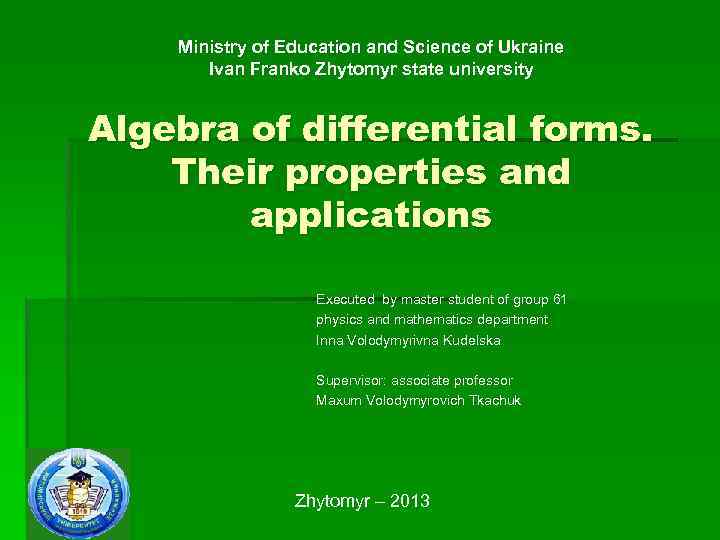 Ministry of Education and Science of Ukraine Ivan Franko Zhytomyr state university Algebra of differential forms. Their properties and applications Executed by master student of group 61 physics and mathematics department Inna Volodymyrivna Kudelska Supervisor: associate professor Maxum Volodymyrovich Tkachuk Zhytomyr – 2013
Ministry of Education and Science of Ukraine Ivan Franko Zhytomyr state university Algebra of differential forms. Their properties and applications Executed by master student of group 61 physics and mathematics department Inna Volodymyrivna Kudelska Supervisor: associate professor Maxum Volodymyrovich Tkachuk Zhytomyr – 2013
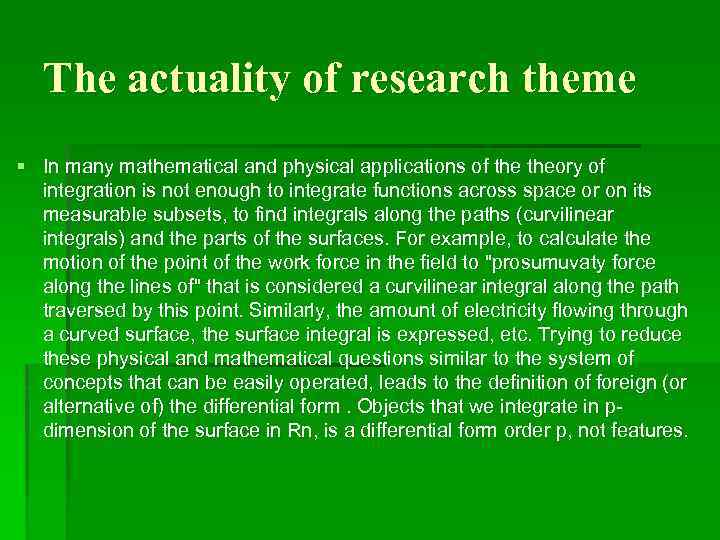 The actuality of research theme § In many mathematical and physical applications of theory of integration is not enough to integrate functions across space or on its measurable subsets, to find integrals along the paths (curvilinear integrals) and the parts of the surfaces. For example, to calculate the motion of the point of the work force in the field to "prosumuvaty force along the lines of" that is considered a curvilinear integral along the path traversed by this point. Similarly, the amount of electricity flowing through a curved surface, the surface integral is expressed, etc. Trying to reduce these physical and mathematical questions similar to the system of concepts that can be easily operated, leads to the definition of foreign (or alternative of) the differential form. Objects that we integrate in pdimension of the surface in Rn, is a differential form order p, not features.
The actuality of research theme § In many mathematical and physical applications of theory of integration is not enough to integrate functions across space or on its measurable subsets, to find integrals along the paths (curvilinear integrals) and the parts of the surfaces. For example, to calculate the motion of the point of the work force in the field to "prosumuvaty force along the lines of" that is considered a curvilinear integral along the path traversed by this point. Similarly, the amount of electricity flowing through a curved surface, the surface integral is expressed, etc. Trying to reduce these physical and mathematical questions similar to the system of concepts that can be easily operated, leads to the definition of foreign (or alternative of) the differential form. Objects that we integrate in pdimension of the surface in Rn, is a differential form order p, not features.
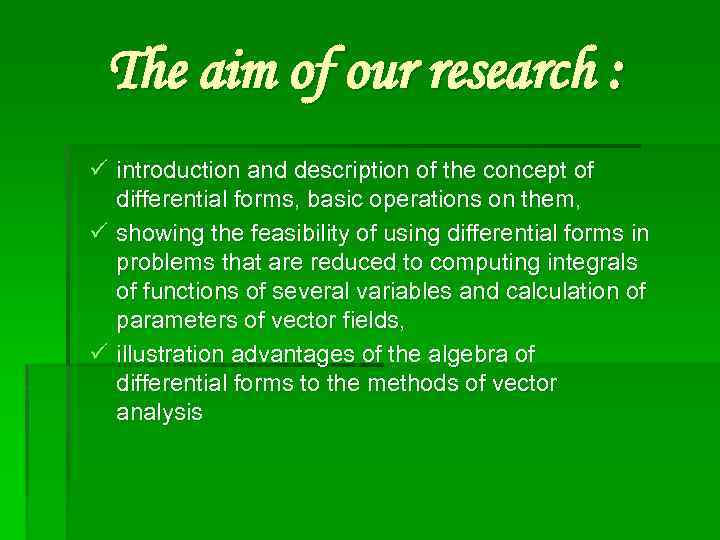 The aim of our research : ü introduction and description of the concept of differential forms, basic operations on them, ü showing the feasibility of using differential forms in problems that are reduced to computing integrals of functions of several variables and calculation of parameters of vector fields, ü illustration advantages of the algebra of differential forms to the methods of vector analysis
The aim of our research : ü introduction and description of the concept of differential forms, basic operations on them, ü showing the feasibility of using differential forms in problems that are reduced to computing integrals of functions of several variables and calculation of parameters of vector fields, ü illustration advantages of the algebra of differential forms to the methods of vector analysis
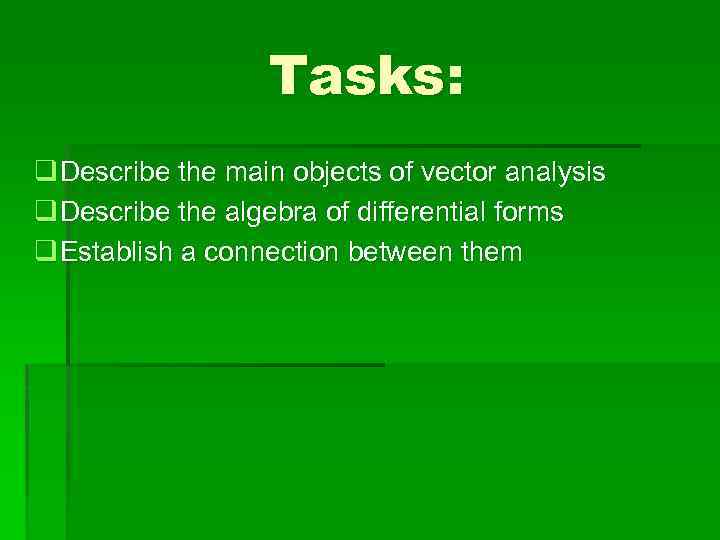 Tasks: q Describe the main objects of vector analysis q Describe the algebra of differential forms q Establish a connection between them
Tasks: q Describe the main objects of vector analysis q Describe the algebra of differential forms q Establish a connection between them
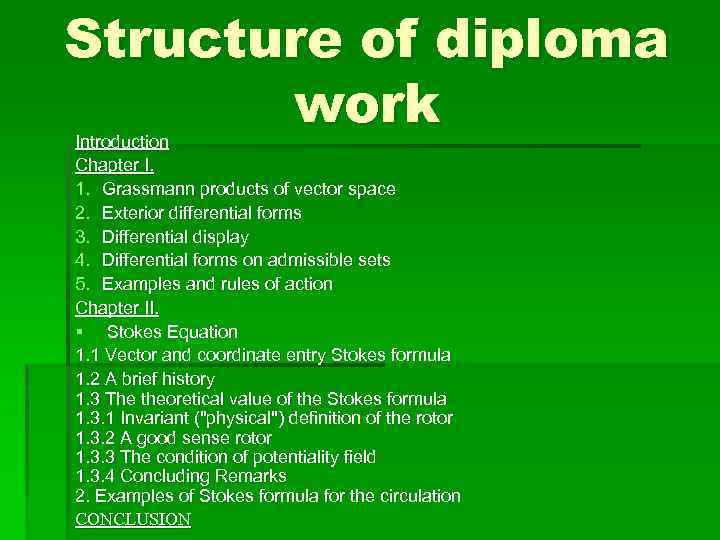 Structure of diploma work Introduction Chapter I. 1. Grassmann products of vector space 2. Exterior differential forms 3. Differential display 4. Differential forms on admissible sets 5. Examples and rules of action Chapter II. § Stokes Equation 1. 1 Vector and coordinate entry Stokes formula 1. 2 A brief history 1. 3 The theoretical value of the Stokes formula 1. 3. 1 Invariant ("physical") definition of the rotor 1. 3. 2 A good sense rotor 1. 3. 3 The condition of potentiality field 1. 3. 4 Concluding Remarks 2. Examples of Stokes formula for the circulation CONCLUSION
Structure of diploma work Introduction Chapter I. 1. Grassmann products of vector space 2. Exterior differential forms 3. Differential display 4. Differential forms on admissible sets 5. Examples and rules of action Chapter II. § Stokes Equation 1. 1 Vector and coordinate entry Stokes formula 1. 2 A brief history 1. 3 The theoretical value of the Stokes formula 1. 3. 1 Invariant ("physical") definition of the rotor 1. 3. 2 A good sense rotor 1. 3. 3 The condition of potentiality field 1. 3. 4 Concluding Remarks 2. Examples of Stokes formula for the circulation CONCLUSION
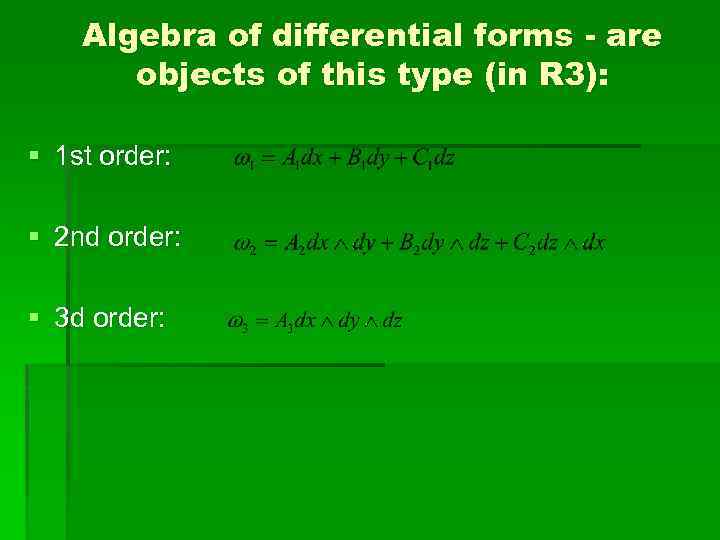 Algebra of differential forms - are objects of this type (in R 3): § 1 st order: § 2 nd order: § 3 d order:
Algebra of differential forms - are objects of this type (in R 3): § 1 st order: § 2 nd order: § 3 d order:
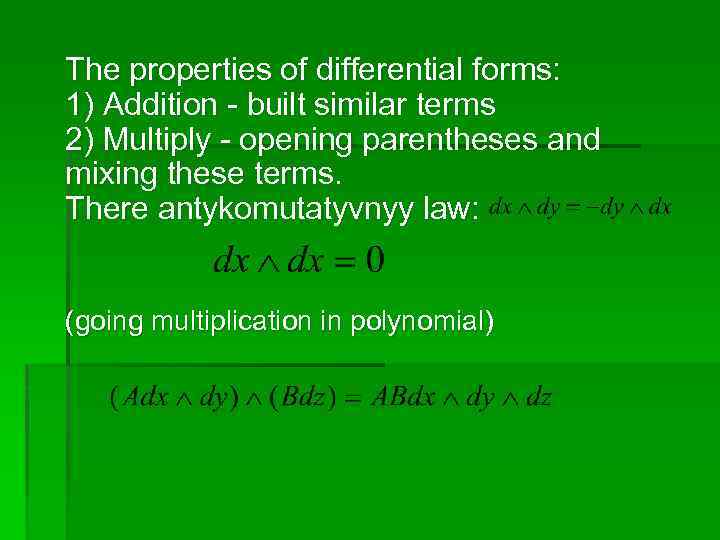 The properties of differential forms: 1) Addition - built similar terms 2) Multiply - opening parentheses and mixing these terms. There antykomutatyvnyy law: (going multiplication in polynomial)
The properties of differential forms: 1) Addition - built similar terms 2) Multiply - opening parentheses and mixing these terms. There antykomutatyvnyy law: (going multiplication in polynomial)
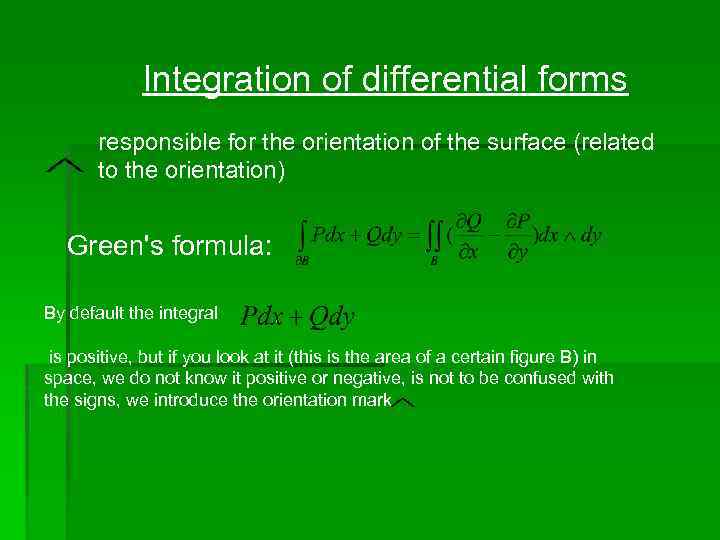 Integration of differential forms responsible for the orientation of the surface (related to the orientation) Green's formula: By default the integral is positive, but if you look at it (this is the area of a certain figure B) in space, we do not know it positive or negative, is not to be confused with the signs, we introduce the orientation mark
Integration of differential forms responsible for the orientation of the surface (related to the orientation) Green's formula: By default the integral is positive, but if you look at it (this is the area of a certain figure B) in space, we do not know it positive or negative, is not to be confused with the signs, we introduce the orientation mark
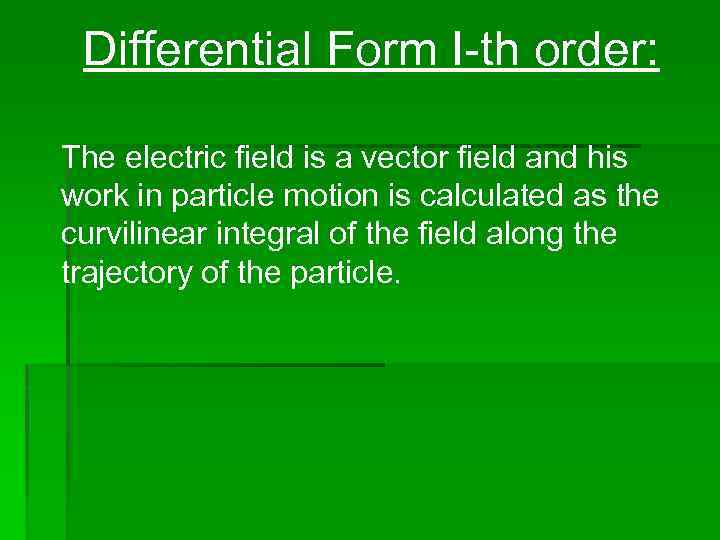 Differential Form I-th order: The electric field is a vector field and his work in particle motion is calculated as the curvilinear integral of the field along the trajectory of the particle.
Differential Form I-th order: The electric field is a vector field and his work in particle motion is calculated as the curvilinear integral of the field along the trajectory of the particle.
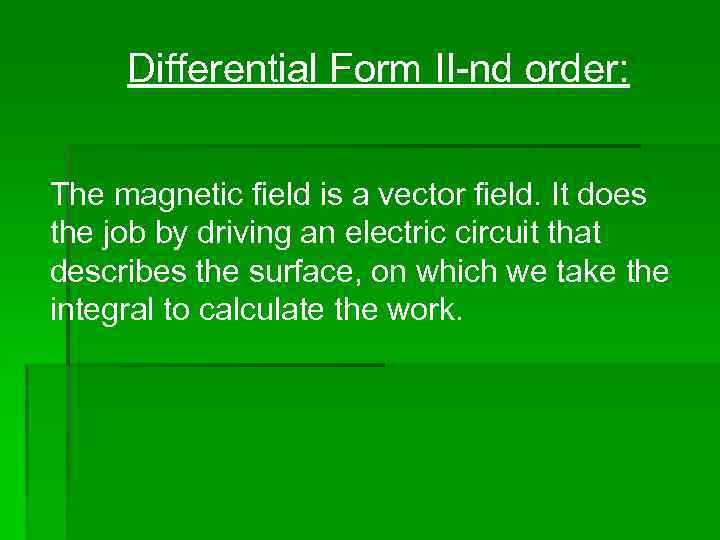 Differential Form II-nd order: The magnetic field is a vector field. It does the job by driving an electric circuit that describes the surface, on which we take the integral to calculate the work.
Differential Form II-nd order: The magnetic field is a vector field. It does the job by driving an electric circuit that describes the surface, on which we take the integral to calculate the work.
 Thank you for attention!
Thank you for attention!


